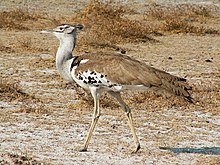Kori bustard
| Kori bustard | |
|---|---|
 |
|
| Nominate subspecies, taken in Etosha National Park, Namibia | |
| Scientific classification | |
| Kingdom: | Animalia |
| Phylum: | Chordata |
| Class: | Aves |
| Order: | Otidiformes |
| Family: | Otididae |
| Genus: | Ardeotis |
| Species: | A. kori |
| Binomial name | |
|
Ardeotis kori (Burchell, 1822) |
|
The kori bustard (Ardeotis kori) is the largest flying bird native to Africa. It is a member of the bustard family, which all belong to the order Otidiformes and are restricted in distribution to the Old World. It is one of the four species (ranging from Africa to India to Australia) in the large-bodied Ardeotis genus. In fact, the male kori bustard may be the heaviest living animal capable of flight.
This species, like most bustards, is a ground-dwelling bird and an opportunistic omnivore. Male kori bustards, which can be more than twice as heavy as the female, attempt to breed with as many females as possible and then take no part in the raising of the young. The nest is a shallow hollow in the earth, often disguised by nearby obstructive objects such as trees.
English naturalist William John Burchell described the kori bustard in 1822. The specific epithet kori is derived from the Tswana name for this bird - Kgori.
Two subspecies are currently recognized:
The kori bustard is cryptically coloured, being mostly grey and brown, finely patterned with black and white coloring. The upper parts and neck are a vermiculated black and greyish-buff colour. The ventral plumage is more boldly colored, with white, black and buff. The crest on its head is blackish in coloration, with less black on the female's crest. There is a white eye stripe above the eye. The chin, throat and neck are whitish with thin, fine black barring. A black collar at the base of the hind-neck extends onto the sides of the breast. The feathers around the neck are loose, giving the appearance of a thicker neck than they really have. The belly is white and the tail has broad bands of brownish-gray and white coloration. Their feathers contain light sensitive porphyrins, which gives their feathers a pinkish tinge at the base- especially noticeable when the feathers are shed suddenly. The head is large and the legs are relatively long. The eye is pale yellow, while the bill is light greenish horn coloured, relatively long, straight and rather flattened at the base. The legs are yellowish. The feet have three forward facing toes. Females are similar in plumage but are much smaller, measuring about 20-30% less in linear measurements and often weighing 2-3 times less than the male. The female is visibly thinner legged and slimmer necked. The juvenile is similar in appearance to the female, but is browner with more spotting on the mantle, with shorter crest and neck plumes. Male juveniles are larger than females and can be the same overall size as the adult male but tends to be less bulky with a thinner neck, shorter head crest, paler eyes and a darker mantle.
...
Wikipedia

